DownNDirty
Bronze Member
Those of you who read my last post know that I recently dug what I thought was my first Spanish cob, but unfortunately turned out to be a contemporary counterfeit. Still a cool find but not the same as the real thing.
Sunday I headed back to a coastal area where I had previously scouted in search of a very old site I had read about while doing some research. On the way to the target location my buddy and I tried another promising spot and had enough luck to make us want to go back there later on. He dug a brass button and I found a square nail, which are good signs that an 18th-19th century home site may be close by. Other than the nail my only find from that spot was this "Tallio" cuff link-a first for me. These were worn by fox hunting enthusiasts in the late 1700s.

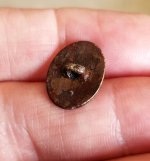
Not finding a lot we headed out in search of the other site. Not long after we started hunting there it became clear that we had found it; the age and quality of the finds that followed told me that all the research was well worth the effort.
After digging a few trash targets (mainly fishing sinkers) I hit on a promising signal about 5 inches deep. When I dug out the target I could see that it was a small flat disk with an irregular shape. Could it be? Nah, I couldn't be that lucky, not after digging a counterfeit cob a couple of weeks ago. But as soon as I rinsed the dirt away there it was-a beautiful 1730 one real Spanish cob with tons of detail!
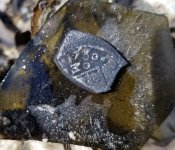
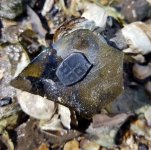
Man I did the happy dance right then and there-what an adrenaline rush! My first cob-and there was no doubt that this one is the genuine article. Minted in Mexico City in 1730, which was one of the last few years that cobs were struck there.


After the buzz wore off a little it was time to get back it. Not long after the cob I dug what I thought was a large copper but turned out to be a pewter coat button. Then an early brass buckle.
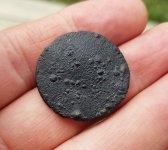
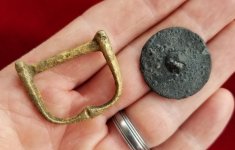
Another interesting target was this "Operator" tag/badge from Charleston dated 1942. I'm having a hard time identifying it-any input would be appreciated.
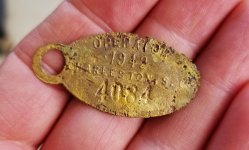
I dug another pewter button and put it in the finds box not thinking much of it. It wasn't until I was cleaning the finds that night that I realized it has the letters "PN" on the back. There has been a debate about these buttons for years. Many people say that they were worn by American troops in the Revolutionary War, possibly by Francis Marion's men. Almost all of the ones that have been recovered have come from the Lowcountry area of South Carolina as did this one, and most from known areas of Rev War activity. The button I dug Sunday is pictured next to another "PN" button I dug a couple of years ago at a Rev War campsite.
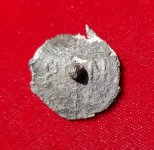

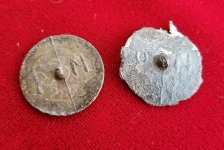
Other finds at the site included a pewter spoon handle (1700s), a nickel silver fork from about 1930, brass escutcheons and other decorative pieces, and the neck of a very early black glass bottle.

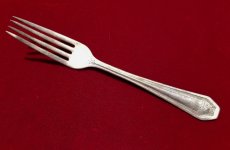


A lot of lead was dug also, some old and plenty of fishing sinkers. A couple of pieces look like they could be flint holder pads for flintlock muskets.
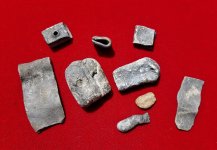

Here are all of my finds for the day, and a picture of the three best ones. All i all it was a great day of detecting, one that I will remember for a long time. Can't wait to get back to the honey hole!
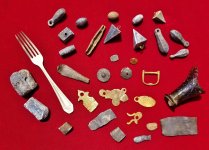
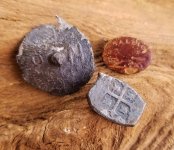
Sunday I headed back to a coastal area where I had previously scouted in search of a very old site I had read about while doing some research. On the way to the target location my buddy and I tried another promising spot and had enough luck to make us want to go back there later on. He dug a brass button and I found a square nail, which are good signs that an 18th-19th century home site may be close by. Other than the nail my only find from that spot was this "Tallio" cuff link-a first for me. These were worn by fox hunting enthusiasts in the late 1700s.


Not finding a lot we headed out in search of the other site. Not long after we started hunting there it became clear that we had found it; the age and quality of the finds that followed told me that all the research was well worth the effort.
After digging a few trash targets (mainly fishing sinkers) I hit on a promising signal about 5 inches deep. When I dug out the target I could see that it was a small flat disk with an irregular shape. Could it be? Nah, I couldn't be that lucky, not after digging a counterfeit cob a couple of weeks ago. But as soon as I rinsed the dirt away there it was-a beautiful 1730 one real Spanish cob with tons of detail!


Man I did the happy dance right then and there-what an adrenaline rush! My first cob-and there was no doubt that this one is the genuine article. Minted in Mexico City in 1730, which was one of the last few years that cobs were struck there.


After the buzz wore off a little it was time to get back it. Not long after the cob I dug what I thought was a large copper but turned out to be a pewter coat button. Then an early brass buckle.


Another interesting target was this "Operator" tag/badge from Charleston dated 1942. I'm having a hard time identifying it-any input would be appreciated.

I dug another pewter button and put it in the finds box not thinking much of it. It wasn't until I was cleaning the finds that night that I realized it has the letters "PN" on the back. There has been a debate about these buttons for years. Many people say that they were worn by American troops in the Revolutionary War, possibly by Francis Marion's men. Almost all of the ones that have been recovered have come from the Lowcountry area of South Carolina as did this one, and most from known areas of Rev War activity. The button I dug Sunday is pictured next to another "PN" button I dug a couple of years ago at a Rev War campsite.



Other finds at the site included a pewter spoon handle (1700s), a nickel silver fork from about 1930, brass escutcheons and other decorative pieces, and the neck of a very early black glass bottle.




A lot of lead was dug also, some old and plenty of fishing sinkers. A couple of pieces look like they could be flint holder pads for flintlock muskets.


Here are all of my finds for the day, and a picture of the three best ones. All i all it was a great day of detecting, one that I will remember for a long time. Can't wait to get back to the honey hole!


Amazon Forum Fav 👍
Last edited:
Upvote
56










